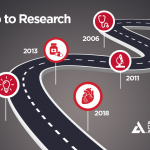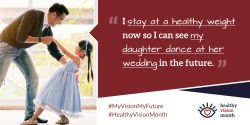BY OCTOBER 23, 2018 – 5:52 PM HEALTH
By American Diabetes Association
Thanks to the continued support of over 500,000 diabetes advocates like each of you, we continue to address the barriers faced by people with diabetes in their everyday life. Our fall newsletter outlines important highlights of activities from across the country. We recently celebrated a historic win that was achieved through a legal advocacy victory nearly 2 decades in the making. Because of the unwavering dedication of our Legal Advocacy team and volunteers, ADA successfully advocated against the U.S. Department of Transportation Federal Motor Carrier Safety Administration’s blanket ban against use of insulin that had been federal law since 1970! We achieved this critical change for people with diabetes due to your invaluable support—Thank You! As we enter American Diabetes Month next month, let’s end the year strong! Continue to raise your voice, share your story, and help us make a difference for the more than 30 million children and adults living with diabetes.
Federal Affairs
The Federal Government Affairs team and our dedicated Diabetes Advocates have been busy promoting the need for increased funding for diabetes research and programs; advocating for access to affordable insulin; and defending the provisions of the Affordable Care Act (ACA) that benefit people with diabetes.
Federal Funding for Diabetes Research and Programs:
As Diabetes Advocates may be aware, earlier this year President Trump threatened to veto any omnibus legislation that crossed his desk. Taking this threat seriously, House and Senate appropriators advanced funding legislation for fiscal year (FY) 2019 more quickly than in recent history.
The House Labor, Health and Human Services, Education, and Related Agencies (LHHS) Appropriations Subcommittee considered and approved its FY 2019 bill on June 15. The full Senate approved legislation comprised of its FY 2019 LHHS funding bill and the House-passed Department of Defense (DoD) Appropriations Act (H.R. 6157) on August 23. Due to the often-contentious nature of LHHS funding, coupling defense and LHHS meant that the LHHS bill was more likely to be approved before the October 1 start of FY 2019. Senate Appropriations Chairman Richard Shelby (R-AL) and Ranking Member Patrick Leahy (D-VT) were adamant that they would not allow partisan policy riders in any FY 2019 appropriations legislation. The combined appropriations bill included $2,030,892,000 for National Institute of Diabetes and Digestive and Kidney Diseases ($59 million increase over FY 2018), $148,129,000 for DDT (level funding), and $25,300,000 for the National DPP (level funding).
On September 13, ADA joined 337 organizations at the Rally for Medical Research, a coordinated effort to call on Congress with one unified voice to increase funding for biomedical research at the National Institutes of Health (NIH). LaShawn McIver, MD, MPH, Vice President of Government Affairs, Advocacy, and Community Integrated Health, Allison McElvaine, PhD, Vice President, Research & Scientific Programs, and ADA’s federal team were joined by volunteer advocates Alvin C. Powers, MD, the Joe C. Davis Chair in Biomedical Science, and Professor of Medicine and Director of the Division of Diabetes, Endocrinology and Metabolism at Vanderbilt University School of Medicine ; and Stephanie Sisley, MD, Assistant Professor, Baylor College of Medicine, Children’s Nutrition Research Center, to make the case for increased research funding.
The text of the final FY 2019 LHHS Appropriations legislation was released that day, and rally participants celebrated a proposed increase of $2 billion in overall funding for NIH.
In the final bill, ADA’s priorities for the Centers for Disease Control and Prevention—the Division of Diabetes Translation and the National Diabetes Prevention Program—were funded at the same level as FY 2018, and NIH’s NIDDK received a $59 million increase. The House and Senate both approved the final conference legislation in September, clearing the way for the president to sign the bill, which included FY 2019 Department of Defense funding and a continuing resolution for unfunded agencies through December 7, on Friday, September 29, marking the first time in 22 years that LHHS priorities were funded in full prior to the start of a new fiscal year.
Diabetes Advocates should be proud of the effectiveness of their advocacy, which led to increased and stable funding for each of the key ADA priority programs in the new fiscal year. We encourage advocates to consider sending Congress a message of appreciation for their support and continued investment in critical diabetes research and programs. You can send your message via ADA’s Grassroots Action Center.
State Government Affairs
Entering the fourth quarter of 2018, the ADA team has initiated over 300 individual actions on prevention, health equity, and health care legislation and regulation in states across the country. These actions include meetings with legislators, briefings to legislative bodies, letters and alerts, and participation in lobby day activities. Without question, legislators and agencies from coast to coast are hearing the voices of our ADA advocates and staff. To date, we’ve achieved 52 state wins, and we expect to see resolution on many of the bills pending before the end of the year. This past month, several pieces of important ADA-supported legislation protecting health care for people with diabetes were approved in California, including legislation that prohibits Medi-Cal from decreasing benefit coverage due to work or community engagement requirements; prohibits short-term, limited duration health plans; and legislation that ensures consumers get charged the lowest possible price for their medications. In Vermont, the ADA was part of an effort to influence emergency regulations for Association Health Plans which resulted in the addition of several consumer protections that will benefit people with diabetes.
As reported throughout the year, ADA is also achieving significant wins in our other priority areas to secure new and maintain existing state budget allocations for prevention programs. We have also regularly engaged in legislation and regulation aimed at advancing prevention policy, increasing health equity, and protecting against discriminatory policies for students and drivers with diabetes.
Diabetes Advocates will have a busy and active end-of-year as we will be calling on advocates like you to help us close out pending legislation and regulation as the year comes to a close. For a complete list of state legislation, please feel free to contact Lisa Murdock, Vice President, State Government Affairs at lmurdock@diabetes.org.
LEGAL ADVOCACY
Over the summer, we entered the busy back-to-school season for families of children with diabetes, and in early fall, we celebrated a regulatory victory that was more than two decades in the making. Needless to say, the Legal Advocacy team has been very busy!
Raising Our Voice
In mid-September, following more than two decades of advocacy by the ADA, the U.S. Department of Transportation Federal Motor Carrier Safety Administration (FMCSA) published a Final Rule on diabetes. The new rule eliminates the blanket ban against use of insulin by commercial drivers that had been federal law since 1970. Although an exemption program has been available since 2003, once an individual began using insulin, it was a cumbersome and lengthy process to return to the road. It was common for people to avoid or delay going on insulin, to the detriment of their health, because the time required to receive an exemption meant six or more months without driving, often without income.
The new rule is modern, fair, and flexible. It is based in individual assessment and recognizes the significant advances in diabetes science, medicine, and technology that today allow people with diabetes to effectively manage their diabetes in ways not possible when the old rule was written in the late 1960s. The final rule gives great deference to the expertise and judgement of the individual’s treating physician, and it references the authority of the ADA and our advocacy throughout the years.
The new rule takes effect on November 19. We have posted a Frequently Asked Questions document to address the various questions for impacted individuals, and we are developing an education campaign to reach more people with information.
Supporting People with Diabetes
Summer and early fall are our busiest times of the year as kids return to school and families seek the ADA’s help navigating the challenging process of managing diabetes at school. To support schools, we finished an update to our training modules, Diabetes Care Tasks at School: What Key Personnel Need to Know. These and other training materials are available at diabetes.org/schooltraining. To help guide and support parents and families of children with diabetes, we recorded a Safe at School back to school webinar with Crystal Woodward, Director, Safe at School. This webinar is available on demand.
To better understand how our legal services influence constituents and to inform potential programmatic enhancements, we conducted a survey of people who contacted the ADA and were helped by our Legal Advocate Program from June 2017-May 2018, about education, childcare, and camp related discrimination issues. The survey’s findings will help us refine our program and how we communicate about the impact of our services for people with diabetes. Key takeaways from the survey include:
- From 2017–2018, constituents with a diabetes-related discrimination issue in an education, childcare, or camp setting increased their confidence to advocate for their rights by 63% after leveraging ADA Legal Advocacy support and resources.
- These constituents increased their knowledge of the Americans with Disabilities Act by 65% and of Section 504 of the Rehabilitation Act by 60% after working with the ADA Legal Advocacy team.
- Nearly two-thirds reported a positive result of their advocacy efforts, such as an increase in nurse coverage at school or in the number of staff trained on diabetes care after working with the ADA Legal Advocacy team.
We continue to share stories about the people we are helping and the impact of our work to both promote the importance and effectiveness of ADA Legal Advocacy and to raise awareness about available services and support. Along these lines, a man whose type 2 diabetes never interfered with his job until he began experiencing foot pain needed extra leave from work in order to receive treatment. His employer refused additional medical leave or to discuss reasonable accommodations that would allow him to return to work. Out of work for months, without any pay or disability benefits, James contacted the ADA for help. With guidance and support from an ADA Legal Advocacy attorney, James successfully advocated for himself. Read his full story on the Diabetes Stops Here blog.
Grassroots Advocacy
Diabetes Advocates, once again, demonstrated their passion, commitment, and effectiveness over the summer and early fall. Whether responding swiftly to action alerts, helping to grow the Advocate Network, or by participating in meetings with congressional members and staff at home, Diabetes Advocates continued to raise the bar and set a national example of the power of advocacy.
Taking Action
Advocates have been busy, responding to 15 calls to action—on state-based and federal issues, as well as Legal Advocacy—all of which were deployed since July alone. Diabetes Advocates raised their voice time and again to ensure the ADA’s message about the critical need to support people with diabetes is received by the nation’s decision makers. Issues we confronted ranged from insulin affordability to supporting federal diabetes research, to health insurance, to providing diabetes self-management training to Medicare beneficiaries, and more. Beyond calls to action, we were pleased to be able to invite state-based advocates to an ADA Advocacy training in the field. In addition, our Congress at Home campaign in August achieved outstanding results and engagement with members of Congress to discuss policies and legislation impacting people with diabetes. This year, the Grassroots Advocacy team piloted broader outreach to Diabetes Advocates and asked them to meet with members of Congress to ensure that people with diabetes are represented and understood on Capitol Hill. This new tactic brought a new highly engaged constituents into the ADA Advocacy fold, and given the success, we are looking to expand outreach in the future.
Empowering Advocates – Grassroots Webinars
As a new element of this year’s Advocates in Action activities, the Grassroots Advocacy team hosted a well-attended webinar focused on how to educate candidates for public office, and the legal boundaries and requirements associated with this type of advocacy. Specifically, the webinar informed Advocates about the importance of candidate education and the value of the relationships that can be forged with those seeking office at the onset. In addition, the webinar provided training and guidance on the legal parameters for outreach and advocacy to candidates running for office and in general. Both traditional advocacy, like in person meetings, and non-traditional advocacy engagement, such as social media, require clear understanding of legal requirements and boundaries to ensure Advocates remain in step with the law.
During the webinar, Diabetes Advocates were encouraged to seek meetings with ALL candidates for public office ahead of the November election to provide basic education on the impact and reality of diabetes, key priorities, and opportunities for public policy intervention, and to offer themselves and the ADA as a resource to the candidate if they have questions or need more information.
A comprehensive set of supporting resources were provided to advocates during the webinar, and as follow-up, including template invitation for meetings with candidates; step-by-step guide to candidate education; and legal guidance sheet for ADA advocacy and lobbying. These resources, as well as the webinar’s audio recording and accompanying slides, can be accessed on the ADA website.
Congress at Home – Recap
By all accounts, the ADA’s 2018 Congress at Home initiative was an excellent success as Diabetes Advocates hosted nearly 60 meetings with Congressional members and their staff across the country. Perhaps more impressive and invaluable to this year’s effort, upward of 80% of the meetings held were with key congressional member offices – specifically those with direct influence and jurisdiction over ADA federal policy priorities and asks. We are also pleased to share that as a result of this year’s Congress at Home activities, a number of new Diabetes Advocates became engaged with ADA advocacy in a new and more advanced manner.
This year’s Congress at Home meetings are already bearing fruit as the ADA team has already begun direct follow-up with congressional offices to build on conversations Diabetes Advocates began during at-home meetings. Once again, Diabetes Advocates proved their dedication and passion, surpassing this year’s goal to host 50 meetings, and, in a more overarching way, to continue vital conversations about policy priorities as follow up to a successful Call to Congress in the spring.
Insulin Affordability
We are pleased to share that the insulin affordability petition has been signed by over 400,000 people, including the addition of more than 123,000 signatures in the first three quarters of 2018 alone. Garnering 400,000 signatures is both a critical milestone and a symbol of the salience this issue has for the diabetes community. The ADA is currently developing an ongoing engagement strategy specific to insulin affordability to continue to mobilize advocate interest and passion. As always, the advocacy strategy will continue its foundational approach to further inform policymakers and the public at-large about the staggering impact of this issue and critical need for swift resolution. In September, we launched an animated graphics video to help explain the complexities of the insulin supply chain, and urging viewers to join us in taking action by signing the insulin affordability petition and asking their friends, family and colleagues to do the same.
Call to Congress 2019
We are thrilled to share our 2019 Call to Congress convening in Washington, DC, has been set for March 27 – 29, 2019. A save-the-date for the ADA’s premier advocacy event was sent to the full advocate network in mid-September, complimented by a second save-the-date message sent specifically to an expanded group of diabetes researchers across the country.
In addition to this year’s in-person convening, we have expanded the scope of the Call to Congress campaign to span a nine-month timeline with specific Call to Congress communications, training, and engagement opportunities for the advocate network at-large. Advocates across the nation will be given a day-by-day action plan that will coincide with the in-person convening in Washington. Whether by social media posts, emails and phone calls to Congress, or sharing their story, every one of the ADA’s 500,000-plus Diabetes Advocates will have an opportunity in 2019 to raise their voice on behalf of those impacted by diabetes. Please save the date and get excited about the role you can play in this year’s Call to Congress campaign!
What’s Around the Corner?
As a part of this November’s American Diabetes Month (ADM) initiative, we will be asking Diabetes Advocates to submit local media pieces to their local newspapers addressing newly elected officials who can support people with diabetes. In the form of opinion editorials (OpEds), these local media pieces will congratulate newly elected officials, welcome the opportunity to work with them in their new role, and highlight ADM and key diabetes stats and priorities – localized whenever possible. While this effort will begin immediately following the November elections, we will encourage submission of local advocacy stories to the media through the remainder of 2018. Slight modifications to templates will be provided in December to adjust for post-ADM messaging. The Grassroots Advocacy team will provide training, technical assistance, and supporting resources, including template press materials and step by step directions for submission, to ensure Diabetes Advocates have the resources and support to be successful.
A refreshed Advocates in Action calendar for 2019 is coming very soon! The 2019 calendar will outline multiple options for ongoing advocacy engagement each month. Redesigned to engage the wider network of Diabetes Advocates, the Advocates in Action calendar will provide the advocacy road map for 2019, laying out easy steps for engagement, accessing training and resources, and anchor initiatives and campaigns that serve as the foundation to our advocacy strategy and tactics. Stay tuned for more information coming soon!
Advocacy is one of the core components needed to fulfill our mission – to prevent and cure diabetes, and to improve the lives of all people affected by the disease. Time and again, Diabetes Advocates have heeded the call to act, with commitment and passion, to deliver an unmistakable message – that we as a nation and a people, must do better to support those impacted by diabetes. There is nothing more powerful than the voices and stories of our advocates – we are grateful for the incredible passion and commitment of Diabetes Advocates, like you, who represent the heart of the ADA’s work.
Public Policy
Prevention: Freeing people from diabetes and all its burdens demands a wholistic approach. Lifestyle management is a fundamental aspect of diabetes care. And we know that improved nutrition and increased physical activity can play key roles in preventing type 2 diabetes and delaying or preventing serious complications. So, as the work to protect and strengthen the Affordable Care Act (ACA), Medicare and Medicaid continues, the ADA has also been advocating for strong, effective prevention policies and regulations at the federal level. Even in an otherwise challenging environment, the ADA’s efforts are resulting in positive changes.
Menu Labeling: May 7, 2018 marked the date that new federal nutritional labeling requirements for restaurant menus went into effect. Authorized by a provision in the ACA, this policy change has been a long-sought goal for ADA and will help all consumers make informed, healthier choices. To make sure the information provided is most useful to people with diabetes and prediabetes, ADA has worked to ensure federal regulators adopt accurate, readable labeling for salad bar foods and vending machine products.
Nutrition Facts Labels: New, improved Nutrition Facts Label requirements for most packaged or canned food products, like those purchased at the grocery store, are now set for implementation on January 1, 2020. This, too, is the product of years of advocacy from the ADA and our coalition partners. In recent months, ADA has pressed federal regulators to ensure they get the details right, weighing in on what counts as dietary fiber, and how to label honey and maple syrup products. On September 26, the ADA Public Policy staff met with leadership of the FDA’s Center for Food Safety and Applied Nutrition, along with several key coalition partners, in a productive conversation to explore these issues.
Dietary Guidelines: At the U.S. Department of Agriculture (USDA), the process is now underway for the 2020 revisions of the Dietary Guidelines for Americans. Released every five years, these guidelines are the federal government’s nutritional advice to the public and shape nutrition policy across the federal government. Consistent with past years, a federal Advisory Committee will be established to review the scientific evidence and inform the development of the updated Dietary Guidelines. In a March 30 comment letter to the USDA, the ADA explained how the Dietary Guidelines Advisory Committee could better consider the link between nutrition and type 2 diabetes risk. And in a September 6 announcement, we learned that our recommendations to review the link between added sugars and diabetes at multiple stages of the lifespan and during pregnancy, were squarely on the Advisory Committee’s detailed agenda.
We are pleased with the progress we’ve made to help people with diabetes and those at risk, so they can make informed food choices. We will keep engaging with regulators wherever we can to keep the momentum going!
From:: http://diabetesstopshere.org/2018/10/23/introduction-lashawn-mciver-senior-vice-president-government-affairs-advocacy-community-integrated-health/



